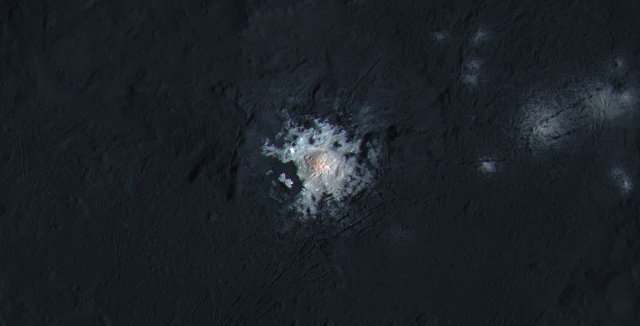
At the 47th Lunar and Planetary Science Conference held last week in The Woodlands, Texas, new results were presented of the analyzes of data collected about the dwarf planet Ceres by NASA’s Dawn space probe. Some of the mission scientists presented a new color map of Ceres surface and new highly detailed pictures of Occator crater, famous for the presence of the largest among the white spots, but also other interesting craters, especially Oxo, where water was found.
The new map of Ceres surface uses colors to emphasize the diversity in its materials and how they relate to its morphology. The blue color is related to flows, smooth plains and mountains, which seem to be very young surface elements. The processes resulting from impacts dominate the geology of the Ceres surface but the scientists identified specific color changes that indicate changes of materials due to complex interactions of the impact process with the subsurface composition. This also provides evidence of one of a subsurface layer enriched of ice and volatile substances.
Concerning the underground, data were presented collected by the Gamma Ray and Neutron Detector (GRaND) instrument, which started acquiring its primary data set in December. Neutrons and gamma rays produced by interactions between cosmic rays and surface materials provide a sort of fingerprint of Ceres’ chemical composition. The measurements are influenced by the composition of the upper meter of the regolith.
Among the results presented there are those obtained thanks to VIR spectrometer, developed by the Italian Space Agency (ASI). It allows to identify the composition of the observed surface and revealed the diversity present in various areas of Ceres. For example, in Haulani crater materials containing carbonates and phyllosilicates were discovered, very different from those present in the surrounding areas.
Another very interesting crater analyzed by the VIR spectrometer is Oxo. It’s about 9 kilometers wide and water was found there. Limited information is available so the water could be bound up in the minerals of the area or the form of ice. This is the first place on Ceres where water has been detected so far.
However, Occator crater is always the one at the center of attention for the presence of the largest white spots on Ceres. The new images of the area are far more detailed than those published in September 2015 and show that it’s not a single bright area but there are more complex structures. This suggests geological activity even in the recent past.
The research on the dwarf planet Ceres entered its hottest phase thanks to the data that the Dawn space probe has been collecting in its lowest orbit. A small world that after all seemed simple to study keeps on proving to be more complex than expected, helping to provide new information about the history of the solar system.



Permalink